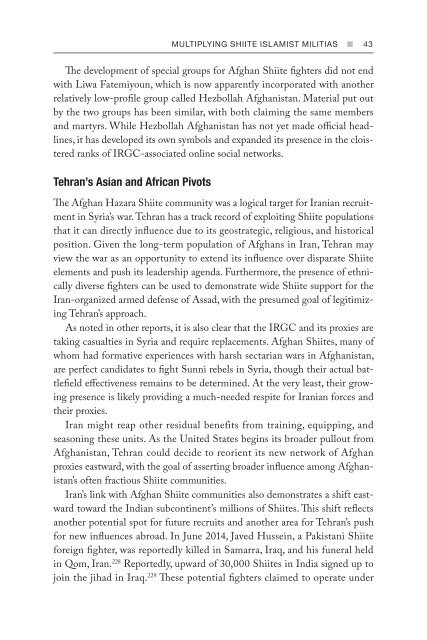Create successful ePaper yourself
Turn your PDF publications into a flip-book with our unique Google optimized e-Paper software.
MULTIPLY<strong>IN</strong>G <strong>SHIITE</strong> ISLAMIST MILITIAS n 43<br />
The development of special groups for Afghan Shiite fighters did not end<br />
with Liwa Fatemiyoun, which is now apparently incorporated with another<br />
relatively low-profile group called Hezbollah Afghanistan. Material put out<br />
by the two groups has been similar, with both claiming the same members<br />
and martyrs. While Hezbollah Afghanistan has not yet made official headlines,<br />
it has developed its own symbols and expanded its presence in the cloistered<br />
ranks of IRGC-associated online social networks.<br />
Tehran’s Asian and African Pivots<br />
The Afghan Hazara Shiite community was a logical target for Iranian recruitment<br />
in Syria’s war. Tehran has a track record of exploiting Shiite populations<br />
that it can directly influence due to its geostrategic, religious, and historical<br />
position. Given the long-term population of Afghans in Iran, Tehran may<br />
view the war as an opportunity to extend its influence over disparate Shiite<br />
elements and push its leadership agenda. Furthermore, the presence of ethnically<br />
diverse fighters can be used to demonstrate wide Shiite support for the<br />
Iran-organized armed defense of Assad, with the presumed goal of legitimizing<br />
Tehran’s approach.<br />
As noted in other reports, it is also clear that the IRGC and its proxies are<br />
taking casualties in Syria and require replacements. Afghan Shiites, many of<br />
whom had formative experiences with harsh sectarian wars in Afghanistan,<br />
are perfect candidates to fight Sunni rebels in Syria, though their actual battlefield<br />
effectiveness remains to be determined. At the very least, their growing<br />
presence is likely providing a much-needed respite for Iranian forces and<br />
their proxies.<br />
Iran might reap other residual benefits from training, equipping, and<br />
seasoning these units. As the United States begins its broader pullout from<br />
Afghanistan, Tehran could decide to reorient its new network of Afghan<br />
proxies eastward, with the goal of asserting broader influence among Afghanistan’s<br />
often fractious Shiite communities.<br />
Iran’s link with Afghan Shiite communities also demonstrates a shift eastward<br />
toward the Indian subcontinent’s millions of Shiites. This shift reflects<br />
another potential spot for future recruits and another area for Tehran’s push<br />
for new influences abroad. In June 2014, Javed Hussein, a Pakistani Shiite<br />
foreign fighter, was reportedly killed in Samarra, Iraq, and his funeral held<br />
in Qom, Iran. 228 Reportedly, upward of 30,000 Shiites in India signed up to<br />
join the jihad in Iraq. 229 These potential fighters claimed to operate under


